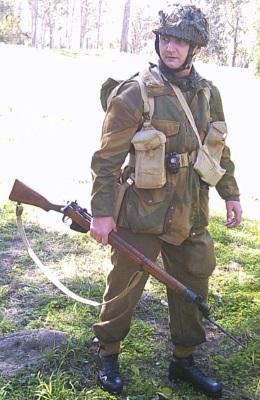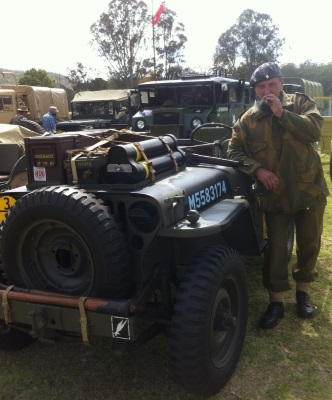AGS has several main nationalities it presents and utilises for group displays, within these are the more specific impressions.
There are also members' own individual presentations that mayb be used at times. All Impressions - group or individual - must be discussed with the Committee.
1st Polish Independant Parachute Brigade
The 1st Polish Independent Parachute Brigade was raised in Scotland in September of 1941.
It was formed from the survivors of the Polish Army who had escaped to Britain after the fall of France, and reinforced by elements that were finally released from Russian prisoner of war camps and repatriated to England via Persia and the Middle East. It was the only allied parachute unit to comprise entirely of men from an occupied country.
While the call went out for volunteers to enlist in the British Airborne Forces, the Polish Brigade Commander Stanislaw Sosabowski did not wait for volunteers. 'Why', he asked, 'should only the brave die?'.....
During the early stages of the war the Brigade was only responsible to Polish command, it's sole purpose being to parachute into Poland and assist with the liberation of their country - an operation that the troops had been training long and hard for. As time wore on the likelyhood of this ever happening rendered the operation impractical and the unit was finally incorporated into the 1st Allied Airborne Army.


This is the 1st Polish Parachute Brigade as it fought at Arnhem (Operation Market Garden) which began with the dropping of British paratroops on Sunday September 17, 1944. Scheduled as the 3rd lift of the airborne assault, only the glider elements were able to take off on September 19, due to other airfields being closed in by fog. The 35 gliders landed amid murderous enemy crossfire on a Landing Zone that was being hotly contested by British troops desperately trying to keep the Zone clear of German counter attacks. Sustaining many casualties, only a third of the unit's desperately needed anti-tank guns reached the Oosterbeek perimeter.
On Thursday, September 21st, approx.1000 Polish paratroops jumped into the battlearea south of the Rhine at Driel, opposite the Oosterbeek perimeter, once again being met with a curtain of fire from every enemy weapon available. Taking up defensive positions around the village, all efforts to reinforce the British perimeter by assaulting the Rhine using dinghys and rafts were met by concentrated enemy machinegun fire and only 250 men eventually succeeded in reaching the beleaguered British position.
1st Infantry Division "Tadeusz Kosciuszko", Polish People's Army (Ludowe Wojsko Polskie)
The history of Polish-Soviet relationships during World War II is a sorry one, involving invasion, occupation, deportation and mass murder. Despite this, a communist “government-in-exile” was established in the Soviet Union in early 1943. Permission was also obtained in May 1943 for the creation of a military arm. This force became the nucleus of the Ludowe Wojsko Polskie (Polish People’s Army).
The first unit to be raised was the First Infantry Division named after the patriot Tadeusz Kosciuszko (1746-1817). The Division recruited former Polish POWs held by the Soviets, Polish deportees to the Soviet Union, gulag workers, partisans, Polish deserters from the Wehrmacht, Ukrainians, Belorussians and Russians of Polish descent and volunteers from the newly liberated territories. Initially officers and NCOs were drawn from the Red Army. All units of the LWP were supplied by the Russians, although use was also made of captured German arms and equipment.
The First Infantry Division served from late1943 to the end of hostilities. It received its baptism in fire in October 1943 as part of the Soviet 33rd Army then engaging XXXIX Panzer Corps at Lenino. Although, the 1st Infantry Division achieved a local breakthrough of German lines, the supporting Red Army units were repulsed and the Division was forced to withdraw with very heavy casualties. The remnants of the division were moved to active reserve until mid 1944.
The Tadeusz Kosciuszko Division became the premier division of the 1st Polish Army and took part in the liberation of Poland (Lublin, Warsaw, Bydgoszcz, Swidwina and Kolobrzeg). During this time, it participated in the controversial failed attempts to force a crossing the Vistula during the Warsaw Rising in late 1944, but was still one of the first units to enter Warsaw on its liberation. After the liberation of Poland, the division pursued the retreating Germans through western Pomerania.
The LWP had expanded sufficiently to form two armies: the 1st (serving with the 1st Belorussian Front) and 2nd (serving with the 1st Ukrainian Front) Polish Armies in the last two years of the war. Both armies participated in the Battle for Berlin.

Initially, many officers and NCOs were Russian, as were their uniforms. As the war progressed the Polish units became more distinctive largely through the adoption of traditional rank insignia, Polish M36 field tunic and four-cornered field cap (rogatywka). Nevertheless, many still wore largely Soviet uniforms and field equipment and were distinguished only by integral epaulettes on the tunics, Polish rank insignia and Piast-style cap eagles. The latter were often disparaging referred to as “plucked chickens” – it is not unusual to see LWP troops, especially after they re-entered Poland wearing the traditional “Amazon Shield” type cap eagle with the crown removed. Early photos of the LWP also show them wearing Soviet helmets emblazoned with the white Piast eagle – this seems to have been dropped in the later stages of the war. Collar pennants indicating branch of service were frequently, but not universally, worn. The LWP also made extensive use of captured German equipment: for example, photos show them using MG42s and wearing German ammunition pouches.
The 1st Infantry Division LWP was an elite and proud unit (a special commemorative badge was issued after the war for veterans). The challenge of re-enacting 1st infantry Division is worth the time and trouble. Furthermore, portrayal of the LWP soldier not only widens the scope of AGS, it also helps to underscore the destructive nature of political ideology and its consequences for the frontline soldier. Within AGS, we have people portraying both the western and eastern Polish armies that resulted from the invasion, division and occupation of their homeland.


